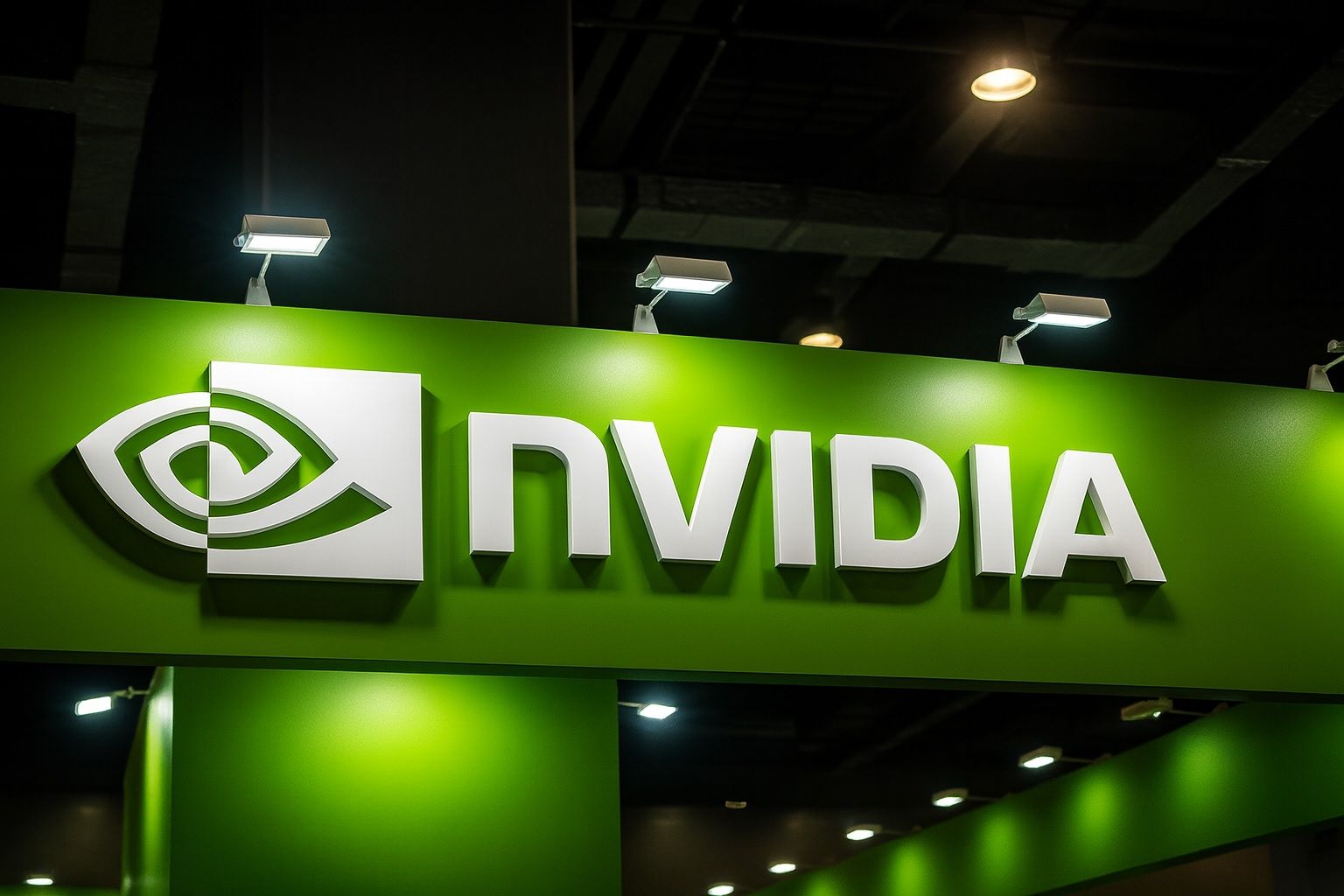- Price & Trend: As of Oct. 17, 2025, NVIDIA (NASDAQ: NVDA) trades around $181–182 [1]. The stock hit an intraday record high of about $195 in early October [2], leaving it roughly +30% year-to-date and ~58% above its price a year ago [3].
- Valuation: The rally has pushed NVIDIA’s market cap to about $4.4 trillion – over 10× larger than AMD (~$350B) and 30× Intel (~$150B) [4] [5]. NVDA trades at roughly 50–53× forward earnings, well above industry norms.
- Earnings: In Q2 FY2026 (ended July 2025), NVIDIA posted revenue of $46.7 billion (+56% YoY) [6]. Data-center (AI) sales were ~$41.1B (≈88% of revenue) [7]. Gaming revenue jumped 49% YoY to $4.3B [8], and automotive/robotics sales grew 69% to $586 M [9]. Gross margins remain sky-high (~72%) and net profits exceed 50% of sales.
- Big Deals & Products: Nvidia has locked in years of demand with megadeals: a 10 GW GPU supply and $100B investment pact with OpenAI [10], a surprise $5 billion equity stake in Intel to co-develop CPUs/GPUs [11], and participation in a $40 billion data-center acquisition consortium [12]. New products like the GeForce RTX 50-series graphics cards (with AI-enhanced gaming) and the DGX Spark mini-supercomputer have also launched recently [13] [14].
- Analyst Outlook: Wall Street is overwhelmingly bullish. About 38 of 47 analysts rate NVDA a “Buy” [15], with the consensus 12-month price target around $210–220 (≈15–20% above today) [16]. Price targets have been rising: Jefferies lifted its NVDA target to $220, and Loop Capital even sees $250 [17]. HSBC’s Frank Lee forecasts a $320 target (78% above current levels) [18]. Loop Capital’s Ananda Baruah calls Nvidia the “leader of the generative-AI golden wave” and says it’s at the “front-end of another material leg” of demand [19] [20].
- Geopolitics & Risks: Trade tensions loom. U.S. export controls have effectively shut Nvidia out of China (formerly ~10–15% of its sales) [21]. CEO Jensen Huang warned that U.S. policy has driven Nvidia’s China share “from 95% market share to 0%” [22]. Beijing has responded with import probes and an antitrust review of Nvidia’s chips [23] [24]. These fears triggered a 4% one-day drop in NVDA stock on Oct. 14 [25]. On the flip side, the U.S. recently eased some curbs – approving new chip exports to the UAE and allowing the tailored H20 AI GPU to be sold in China again [26] – but the China situation remains a wild card.
NVIDIA’s stock has been on a roller-coaster even by tech-stock standards. After surging to all-time intraday highs (~$195) in early October, the shares pulled back into the low-$180s [27] [28] as investors took profits and rotated out of frothy tech names. This volatility partly reflects macro shifts – rising bond yields and strong bank earnings have prompted some fund managers to hedge in October. But even with recent swings, NVDA is up dramatically (nearly 58% over the past year [29]) and remains near its peak levels. Trading volume has been heavy, and the stock’s 50-day moving average sits about 20% above its 200-day average – underscoring the steep upward trajectory of 2025.
Fundamentally, NVIDIA’s results have lived up to the hype. The AI boom is driving massive revenue growth. In Q2 FY2026 (quarter to July 27, 2025), NVIDIA blew past expectations, with $46.7 billion in revenue (56% YoY) [30]. Data-center (AI) sales soared to $41.1 billion [31] – almost 88% of total revenue – as hyperscalers and enterprises raced to deploy Nvidia’s latest GPUs. Even consumer-facing segments got a boost: gaming revenue climbed 49% to $4.3B [32], thanks in part to new GeForce RTX 50-series cards with on-chip AI features. Notably, NVIDIA’s automotive and robotics business is small by comparison (just $586 million in Q2) but still grew 69% year-over-year [33], as self-driving and in-car AI demand rises. The company’s profitability has exploded: gross margins are above 72% [34] and net profit margins top 50%, reflecting the pricing power of Nvidia’s chips and its economies of scale.
CEO Jensen Huang exulted in these results, calling Nvidia’s Blackwell AI platform “the AI platform the world has been waiting for” and noting that production of Blackwell GPUs is “ramping at full speed, and demand is extraordinary” [35]. He pointed out that Nvidia’s new NVLink rack-scale systems are arriving “just in time as reasoning AI models drive orders-of-magnitude increases in performance” [36]. The company isn’t resting on its laurels: at a September event it unveiled its next-gen AI chip architecture (code-named “Rubin”) for advanced tasks, and in early October introduced DGX Spark – marketed as the world’s smallest AI supercomputer – to let researchers run big models locally [37]. In short, NVIDIA is extending its lead at every tier of AI compute, from massive data-center rigs down to desktop workstations.
Behind this surge are a series of mega-partnerships. In late September, Nvidia struck a landmark pact with OpenAI (ChatGPT’s creator) to supply at least 10 GW of GPU capacity and invest up to $100 billion in OpenAI’s AI model development [38]. OpenAI CEO Sam Altman reinforced the significance of the move with his mantra, “Everything starts with compute” [39] – meaning the Intel-to-Apple AI models will rely on Nvidia’s chips at their core. At almost the same time, Nvidia surprised the industry by taking a $5 billion stake in Intel and agreeing to jointly develop new CPU/GPU chips [40]. This unusual alliance locks Nvidia into Intel’s foundries and ties the companies’ futures together (Intel jumped 23% on the news [41]). Other notable deals include Nvidia’s role in a $40 billion investor consortium (with Microsoft, BlackRock, et al.) to buy Aligned Data Centers [42]. In aggregate, these partnerships not only lock in vast future demand for Nvidia hardware, they effectively make Nvidia a partial equity partner in its biggest customers’ infrastructure projects.
Wall Street analysts have cheered these developments. About 38 out of 47 analysts rate NVDA a “Buy” or stronger [43], and the average 12-month price target is around $210–220 (roughly 15–20% above today) [44]. Many firms have lifted their forecasts: for example, Jefferies now sees $220, and Loop Capital raised its target to $250, citing Nvidia’s unmatched position to ride the “next golden wave” of AI demand [45]. In fact, Loop Capital’s Ananda Baruah wrote that “we are entering the next ‘Golden Wave’ of Gen AI adoption and NVDA is at the front-end of another material leg of stronger-than-anticipated demand” [46]. Even more bullish, HSBC’s Frank Lee predicts NVDA could reach $320 in coming months (about 78% upside) on continued AI spending [47].
Analysts do acknowledge the stock’s stratospheric valuation leaves little room for error. Nvidia now trades around 50× forward earnings, well above historical norms, so any stumble could prompt a sharp pullback. Even so, many argue that the AI runway is simply that vast. Melius Research’s Ben Reitzes puts it this way: “If you don’t have the compute, you don’t have a chance. To that end, Broadcom, Nvidia and AMD can all win,” – meaning the AI market is expanding so fast that multiple chipmakers can thrive [48]. Wedbush analyst Dan Ives similarly quipped, “the chip landscape remains [Nvidia’s] world, with everybody else paying rent” [49]. The implication: competitors may win some business, but Nvidia is renting out the crown jewels of AI computing.
Nvidia’s dominance is stark in market share terms. Its GPUs power roughly 80–90% of the world’s AI training servers [50], making it virtually synonymous with AI compute. Its market value ($4.4T) dwarfs rivals – over 10× AMD and 30× Intel [51] [52]. That’s not to say competitors aren’t pushing. AMD, under CEO Lisa Su, has scored headline-grabbing deals. In early October, AMD stunned markets by landing a 6 GW, multi-year AI chip agreement with OpenAI [53] – a direct shot at Nvidia’s relationship with the ChatGPT maker. That news sent AMD’s stock up ~34% in a day [54] (adding about $80B to AMD’s value). Oracle also pledged to incorporate 50,000 of AMD’s upcoming MI450 AI accelerators into its cloud infrastructure by 2026 [55], and Broadcom agreed with OpenAI to supply 10 GW of its accelerators [56]. These moves underscore the industry’s insatiable AI appetite – and validate AMD’s technology – but so far NVIDIA’s share price barely budged (it dipped only ~1% on the AMD news [57]).
Meanwhile Intel – long pounded as an AI laggard – is making a comeback play. Its stock has rallied on government support and partnerships; in mid-October it was up nearly 80% for 2025 [58]. The U.S. has taken a stake in Intel and encouraged the company to boost foundry capacity, and Nvidia’s $5B investment in Intel (for a ~4% stake) was aimed at integrating Intel CPUs with Nvidia GPUs [59]. However, skeptics note Intel still has no true competitor to Nvidia’s AI GPUs. Bank of America even recently downgraded Intel, saying it had “run too far, too fast” without a solid AI product lineup [60]. In short, Intel is trying to catch up, but it remains well behind the 8-bit curve. (Nvidia’s own chips currently power ~90% of AI server installs [61].)
A separate but related risk is geopolitics. U.S. export controls have barred Nvidia’s top AI chips from China, effectively making Nvidia “100% out of China” for now [62]. Huang warned that losing China (the world’s second-largest tech market) is “a mistake” [63], and noted that all Nvidia’s guidance assumes zero China revenue [64]. Chinese regulators have indeed ordered companies to halt Nvidia purchases and are inspecting shipments [65]. This trade war dynamic roiled markets: on Oct. 14, news of Beijing’s probe into U.S. tech firms helped knock NVDA down ~4% in a day [66]. To date Nvidia has complied by selling “derivative” chips (like the RTX 6000D) to China and lobbying for market access. The U.S. side has also relaxed some rules – in October it quietly approved Nvidia’s sale of advanced GPUs to a UAE AI project and allowed the H20 GPU variant back into China [67] – but the bigger picture remains uncertain. Any further clampdown (or escalatory Chinese response) could materially affect future sales.
Amid these headwinds, Nvidia is also cannibalizing its own product lines. (For example, reserves of the older H20 AI chip, previously blocked from China, were sold into non-Chinese accounts – shaving a one-time $180M gain into Q2 results [68].) Still, management projects no slowdown: NVIDIA guided fiscal Q3 revenue of about $54.0 billion (±2%) [69] – roughly +54% year-over-year – even while assuming zero China H20 sales [70]. If Nvidia again beats that lofty forecast (as it has often done), investors could bid the stock higher in anticipation.
Nvidia’s expansion into gaming and automotive bolsters the long-term story. The new RTX 50-series GPUs have refreshed Nvidia’s gaming franchise with AI-powered graphics features [71]. And in cars, Nvidia’s AI chips are finding new use cases. Its automotive and robotics revenue (now ~6% of total) grew nearly 70% last quarter [72], as automakers and tech firms incorporate Nvidia’s Drive platform and AI-boxes into EVs and robots. (At the IAA Mobility show, Nvidia showcased an “AIBOX” for vehicles – a first step toward embedding generative AI assistants in cars.) Elon Musk’s ventures even cross paths with Nvidia: Huang noted Nvidia is investing in Musk’s xAI startup and quipped that “almost everything that Elon is part of, you really want to be part of as well” [73]. Though still small, automotive/robotics may provide a high-growth niche alongside the monster data-center business.
In summary, NVIDIA’s position at the heart of the AI boom is unchallenged. Its combination of best-in-class chips, a rich software ecosystem (CUDA, AI frameworks), and deep customer ties gives it a competitive moat few can match [74]. Loop Capital calls it “the leader of the generative-AI golden wave” [75], and analysts predict Nvidia will far outpace the broader semiconductor sector in coming years. Of course, much of that is already priced in: NVDA’s valuation reflects sky-high expectations (Morgan Stanley estimates global AI data-center spend could reach $3–4 trillion by 2030 [76]). This means short-term swings can be violent – Nvidia’s beta is above 2 – and some insiders have cashed in (Huang himself sold shares at peak prices). Yet for now the narrative remains intact: Nvidia is firing on all cylinders [77], with another blowout earnings report expected on Nov. 19 [78]. Whether it’s charting new product frontiers or navigating geopolitical crosswinds, NVIDIA is the company to watch in semiconductors. And if AI demand keeps up its record pace, many believe the stock has room to run even higher.
Sources: Authoritative financial and tech industry reports, including Nvidia’s own filings [79] [80], market analytics (TechStock²) [81] [82] [83], and reporting from CNBC/Investopedia/Bloomberg [84] [85] [86]. (See citations.)
References
1. ts2.tech, 2. ts2.tech, 3. ts2.tech, 4. ts2.tech, 5. ts2.tech, 6. ts2.tech, 7. ts2.tech, 8. ts2.tech, 9. www.investopedia.com, 10. ts2.tech, 11. ts2.tech, 12. ts2.tech, 13. ts2.tech, 14. ts2.tech, 15. ts2.tech, 16. ts2.tech, 17. ts2.tech, 18. ts2.tech, 19. ts2.tech, 20. ts2.tech, 21. ts2.tech, 22. www.benzinga.com, 23. ts2.tech, 24. www.benzinga.com, 25. ts2.tech, 26. ts2.tech, 27. ts2.tech, 28. ts2.tech, 29. ts2.tech, 30. ts2.tech, 31. ts2.tech, 32. ts2.tech, 33. www.investopedia.com, 34. ts2.tech, 35. nvidianews.nvidia.com, 36. nvidianews.nvidia.com, 37. ts2.tech, 38. ts2.tech, 39. ts2.tech, 40. ts2.tech, 41. ts2.tech, 42. ts2.tech, 43. ts2.tech, 44. ts2.tech, 45. ts2.tech, 46. ts2.tech, 47. ts2.tech, 48. ts2.tech, 49. ts2.tech, 50. ts2.tech, 51. ts2.tech, 52. ts2.tech, 53. ts2.tech, 54. ts2.tech, 55. ts2.tech, 56. ts2.tech, 57. ts2.tech, 58. ts2.tech, 59. ts2.tech, 60. ts2.tech, 61. ts2.tech, 62. www.benzinga.com, 63. www.benzinga.com, 64. www.benzinga.com, 65. ts2.tech, 66. ts2.tech, 67. ts2.tech, 68. nvidianews.nvidia.com, 69. nvidianews.nvidia.com, 70. nvidianews.nvidia.com, 71. ts2.tech, 72. www.investopedia.com, 73. www.investopedia.com, 74. ts2.tech, 75. ts2.tech, 76. ts2.tech, 77. ts2.tech, 78. ts2.tech, 79. nvidianews.nvidia.com, 80. nvidianews.nvidia.com, 81. ts2.tech, 82. ts2.tech, 83. ts2.tech, 84. www.investopedia.com, 85. www.benzinga.com, 86. www.reuters.com







